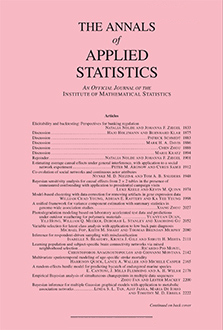Abstract
Although the analysis of human mortality has a well-established history, the attempt to accurately forecast future death-rate patterns for different age groups and time horizons still attracts active research. Such a predictive focus has motivated an increasing shift toward more flexible representations of age-specific period mortality trajectories at the cost of reduced interpretability. Although this perspective has led to successful predictive strategies, the inclusion of interpretable structures in modeling of human mortality can be, in fact, beneficial for improving forecasts. We pursue this direction via a novel b-spline process with locally-adaptive dynamic coefficients. Such a process outperforms state-of-the-art forecasting strategies by explicitly incorporating the core structures of period mortality within an interpretable formulation which enables inference on age-specific mortality trends and the corresponding rates of change across time. This is obtained by modeling the age-specific death counts via a Poisson log-normal model parameterized through a linear combination of b-spline bases with dynamic coefficients that characterize time changes in mortality rates via suitably defined stochastic differential equations. While flexible, the resulting formulation can be accurately approximated by a Gaussian state-space model that facilitates closed-form Kalman filtering, smoothing and forecasting, for both the trends of the spline coefficients and the corresponding first derivatives, which measure rates of change in mortality for different age groups. As illustrated in applications to mortality data from different countries, the proposed model outperforms state-of-the-art methods, both in point forecasts and in calibration of predictive intervals. Moreover, it unveils substantial differences in mortality patterns across countries and ages, both in the past decades and during the covid-19 pandemic.
Funding Statement
This research has been supported by the MIUR–PRIN 2017 project “SELECT” (20177BRJXS). In addition, Daniele Durante acknowledges the support by the MUR–PRIN 2022 project “CARONTE” (2022KBTEBN, funded by the European Union, Next Generation EU) during the final revision of the present article.
Acknowledgments
We are grateful to the Editor, the Associate Editor and the anonymous referees for the valuable comments and for the constructive feedbacks, which helped us in improving the preliminary version of this article. We also thank Stefano Mazzuco and Emanuele Aliverti for the insightful discussion on the data analyzed. Daniele Durante is also affiliated to the Bocconi Institute for Data Science and Analytics.
Citation
Federico Pavone. Sirio Legramanti. Daniele Durante. "Learning and forecasting of age-specific period mortality via B-spline processes with locally-adaptive dynamic coefficients." Ann. Appl. Stat. 18 (3) 1965 - 1987, September 2024. https://doi.org/10.1214/23-AOAS1866
Information





